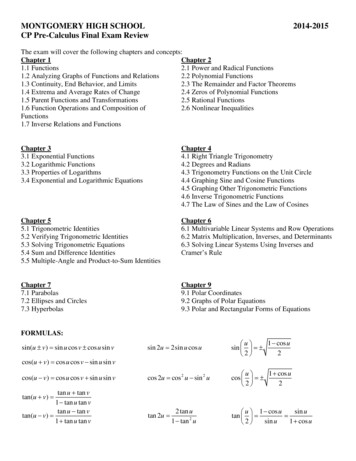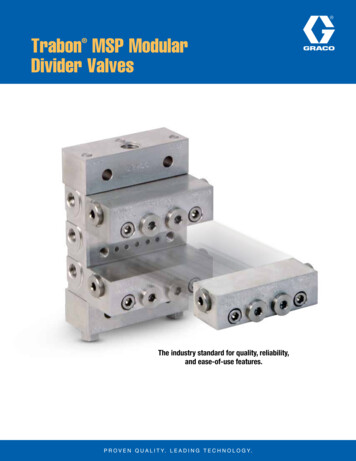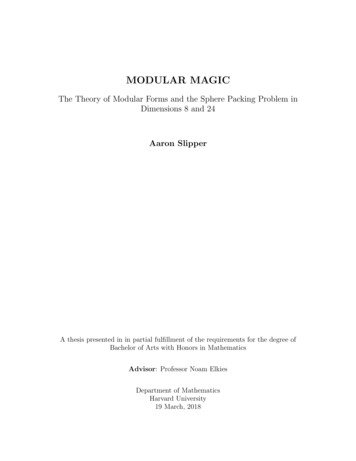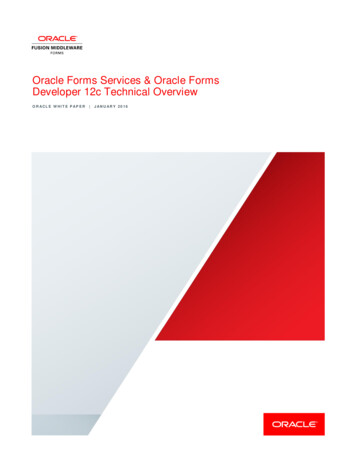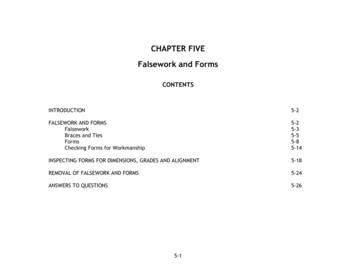
Transcription
Modular Functions and Modular Forms(Elliptic Modular Curves)J.S. MilneVersion 1.31March 22, 2017
This is an introduction to the arithmetic theory of modular functions and modular forms,with a greater emphasis on the geometry than most accounts.BibTeX information:@misc{milneMF,author {Milne, James S.},title {Modular Functions and Modular Forms (v1.31)},year {2017},note {Available at www.jmilne.org/math/},pages {134}}v1.10 May 22, 1997; first version on the web; 128 pages.v1.20 November 23, 2009; new style; minor fixes and improvements; added list of symbols;129 pages.v1.30 April 26, 2010. Corrected; many minor revisions. 138 pages.v1.31 March 22, 2017. Corrected; minor revisions. 133 pages.Please send comments and corrections to me at the address on my websitehttp://www.jmilne.org/math/.The picture shows a fundamental domain fordrawer of H. Verrill.1 .10/,as drawn by the fundamental domainCopyright c 1997, 2009, 2012, 2017 J.S. Milne.Single paper copies for noncommercial personal use may be made without explicit permissionfrom the copyright holder.
ContentsContentsIntroduction . . . . . . . . . . . . . . . . . . . . . . . . . . . . . . . . . . . . .IThe Analytic Theory1Preliminaries . . . . . . . . . . . . . . . . .2Elliptic Modular Curves as Riemann Surfaces3Elliptic Functions . . . . . . . . . . . . . . .4Modular Functions and Modular Forms . . .5Hecke Operators . . . . . . . . . . . . . . .II The Algebro-Geometric Theory6The Modular Equation for 0 .N / . . . . . . . . . . . . . . .7The Canonical Model of X0 .N / over Q . . . . . . . . . . . .8Modular Curves as Moduli Varieties . . . . . . . . . . . . . .9Modular Forms, Dirichlet Series, and Functional Equations . .10 Correspondences on Curves; the Theorem of Eichler-Shimura11 Curves and their Zeta Functions . . . . . . . . . . . . . . . .12 Complex Multiplication for Elliptic Curves Q . . . . . . . . .35.131325414867.87879197101105109121Index131List of Symbols1333
P REREQUISITESThe algebra and complex analysis usually covered in advanced undergraduate or first-yeargraduate courses.R EFERENCESA reference monnnnn is to question nnnnn on mathoverflow.net.In addition to the references listed on p. 12 and in the footnotes, I shall refer to thefollowing of my course notes (available at www.jmilne.org/math/).FT Fields and Galois Theory, v4.52, 2017.AG Algebraic Geometry, v6.02, 2017.ANT Algebraic Number Theory, v3.07, 2017.CFT Class Field Theory, v4.02, 2013.ACKNOWLEDGEMENTSI thank the following for providing corrections and comments for earlier versions of thesenotes: Carlos Barros, Saikat Biswas, Keith Conrad, Tony Feng, Ulrich Goertz, Enis Kaya,Keenan Kidwell, John Miller, Thomas Preu and colleague, Nousin Sabet, Francesc GispertSánchez, Bhupendra Nath Tiwari, Hendrik Verhoek.
IntroductionIt is easy to define modular functions and forms, but less easy to say why they are important,especially to number theorists. Thus I shall begin with a rather long overview of the subject.Riemann surfacesLet X be a connected Hausdorff topological space. A coordinate neighbourhood for X isa pair .U; z/ with U an open subset of X and z a homeomorphism from U onto an opensubset of the complex plane. A compatible family of coordinate neighbourhoods covering Xdefines a complex structure on X. A Riemann surface is a connected Hausdorff topologicalspace together with a complex structure.For example, every connected open subset X of C is a Riemann surface, and the unitsphere can be given a complex structure with two coordinate neighbourhoods, namely thecomplements of the north and south poles mapped onto the complex plane in the standardway. With this complex structure it is called the Riemann sphere. We shall see that a torusR2 Z2 can be given infinitely many different complex structures.Let X be a Riemann surface and V an open subset of X. A function f W V ! C is saidto be holomorphic if, for all coordinate neighbourhoods .U; z/ of X ,f ız1W z.V \ U / ! Cis a holomorphic function on z.V \ U /. Similarly, one can define the notion of a meromorphic function on a Riemann surface.The general problemWe can now state the grandiose problem: study all holomorphic functions on all Riemannsurfaces. In order to do this, we would first have to find all Riemann surfaces. This problemis easier than it looks.Let X be a Riemann surface. From topology, we know that there is a simply connectedtopological space Xz (the universal covering space of X / and a map pW Xz ! X which is alocal homeomorphism. There is a unique complex structure on Xz for which pW Xz ! X is alocal isomorphism of Riemann surfaces. If is the group of covering transformations ofpW Xz ! X, then X D nXz :T HEOREM 0.1 Every simply connected Riemann surface is isomorphic to exactly one ofthe following three:(a) the Riemann sphere;(b) CIdef(c) the open unit disk D D fz 2 C j jzj 1g.P ROOF. Of these, only the Riemann sphere is compact. In particular, it is not homeomorphicto C or D. There is no isomorphism f W C ! D because any such f would be a boundedholomorphic function on C, and hence constant. Thus, the three are distinct. A specialcase of the theorem says that every simply connected open subset of C different from C isisomorphic to D. This is proved in Cartan 1963, VI, 3. The general statement is the famousUniformization Theorem, which was proved independently by Koebe and Poincaré in 1907.See mo10516 for a discussion of the various proofs.25
The main focus of this course will be on Riemann surfaces with D as their universalcovering space, but we shall also need to look at those with C as their universal coveringspace.Riemann surfaces that are quotients of DIn fact, rather than working with D, it will be more convenient to work with the complexupper half plane:H D fz 2 C j .z/ 0g:z iThe map z 7! zCiis an isomorphism of H onto D (in the language of complex analysis, Hand D are conformally equivalent). We want to study Riemann surfaces of the form nH,where is a discrete group acting on H. How do we find such ? There is an obvious biggroup acting on H, namely, SL2 .R/. For D ac db 2 SL2 .R/ and z 2 H, let .z/ DThenaz C b . .z// D cz C d But .adz C bcxz / D .ad az C b:cz C d.az C b/.cxz Cd/D jcz C d j2 D .adz C bcxz/:2jcz C d jbc/ .z/, which equals .z/ because det. / D 1. Hence . .z// D .z/ jcz C d j2for 2 SL2 .R/. In particular,z 2 H H) .z/ 2 H:The matrix I acts trivially on H, and later we shall see that SL2 .R/ f I g is the fullgroup Aut.H/ of bi-holomorphic automorphisms of H (see 2.1). The most obvious discretesubgroup of SL2 .R/ is D SL2 .Z/. This is called the full modular group. For an integerN 0, we define ˇ a b ˇˇ.N / Da 1; b 0; c 0; d 1 mod N :c d ˇIt is the principal congruence subgroup of level N . There are lots of other discrete subgroups of SL2 .R/, but the main ones of interest to number theorists are the subgroups ofSL2 .Z/ containing a principal congruence subgroup.Let Y .N / D .N /nH and endow it with the quotient topology. Let pW H ! Y .N / denotethe quotient map. There is a unique complex structure on Y .N / such that a function f onan open subset U of Y .N / is holomorphic if and only if f ı p is holomorphic on p 1 .U /.Thus f 7! f ı p defines a one-to-one correspondence between holomorphic functions onU Y .N / and holomorphic functions on p 1 .U / invariant under .N /, i.e., such thatg. z/ D g.z/ for all 2 .N /:The Riemann surface Y .N / is not compact, but there is a natural way of compactifyingit by adding a finite number of points. For example, Y .1/ is compactified by adding a singlepoint. The compact Riemann surface obtained is denoted by X.N /.6
Modular functions.A modular function f .z/ of level N is a meromorphic function on H invariant under .N /and “meromorphic at the cusps”. Because it is invariant under .N /, it can be regarded as ameromorphic function on Y .N /, and the second condition means that it is meromorphic whenconsidered as a function on X.N /, i.e., it has at worst a pole at each point of X.N / X Y .N /:For the full modular group, it is easy to make explicit the condition “meromorphic at thecusps” (in this case, cusp). To be invariant under the full modular group means that az C ba bD f .z/ for all2 SL2 .Z/:fc dcz C d Since 10 11 2 SL2 .Z/, we have that f .z C 1/ D f .z/, i.e., f is invariant under the action.z; n/ 7! z C n of Z on C. The function z 7! e 2 iz is an isomorphism C Z ! C X f0g,and so every f satisfying f .z C 1/ D f .z/ can be written in the form f .z/ D f .q/,q D e 2 iz . As z ranges over the upper half plane, q.z/ ranges over C X f0g. To say thatf .z/ is meromorphic at the cusp means that f .q/ is meromorphic at 0, which means thatf has an expansionXf .z/ Dan q n ; q D e 2 iz ;n N0in some neighbourhood of q D 0.Modular forms.To construct a modular function, we have to construct a meromorphic function on H that isinvariant under the action of .N /. This is difficult. It is easier to construct functions thattransform in a certain way under the action of .N /; the quotient of two such functions ofsame type will then be a modular function.This is analogous to the following situation. LetP1 .k/ D .k k X origin/ k and assume that k is infinite. Let k.X; Y / be the field of fractions of kŒX; Y . An f 2 k.X; Y /defines a function .a; b/ 7! f .a; b/ on the subset of k k where its denominator doesn’tvanish. This function will pass to the quotient P1 .k/ if and only iff .aX; aY / D f .X; Y / for all a 2 k :Recall that a homogeneous form of degree d is a polynomial h.X; Y / 2 kŒX; Y such thath.aX; aY / D ad h.X; Y / for all a 2 k . Thus, to get an f satisfying the condition, we needonly take the quotient g h of two homogeneous forms of the same degree with h 0.The relation of homogeneous forms to rational functions on P1 is exactly the same asthe relation of modular forms to modular functions.D EFINITION 0.2 A modular form of level N and weight 2k is a holomorphic functionf .z/ on H such that (a) f . z/ D .cz C d /2k f .z/ for all D ac db 2 .N /I(b) f .z/ is “holomorphic at the cusps”.7
For the full modular group, (a) again implies that f .z C 1/ D f .z/, and so f can bewritten as a function of q D e 2 iz ; condition .b/ then says that this function is holomorphicat 0, so thatXf .z/ Dan q n ; q D e 2 iz :n 0The quotient of two modular forms of level N and the same weight is a modular functionof level N .Affine plane algebraic curvesLet k be a field. An affine plane algebraic curve C over k is defined by a nonzero polynomial f .X; Y / 2 kŒX; Y . The points of C with coordinates in a field K k are the zerosof f .X; Y / in K K; we denote this set by C.K/. We let kŒC D kŒX; Y .f .X; Y // andcall it the ring of regular functions on C . When f .X; Y / is irreducible (for us this is themost interesting case), we let k.C / denote the field of fractions of kŒC and call it the fieldof rational functions on C .@f@fWe say that C W f .X; Y / is nonsingular if f , @X, @Yhave no common zero in thealgebraic closure of k. A point where all three vanish is called a singular point on the curve.E XAMPLE 0.3 Let C be the curve defined by Y 2 D 4X 3f .X; Y / D Y 2aXb, i.e., by the polynomial4X 3 C aX C b:dAssume char k 2. The partial derivatives of f are 2Y and 12X 2 C a D dX. 4X 3 C a/.Thus a singular point on C is a pair .x; y/ such that y D 0 and x is a repeated root of4X 3 aX b. We see that C is nonsingular if and only if the roots of 4X 3 aX b are alldefsimple, which is true if and only if its discriminant D a3 27b 2 is nonzero:P ROPOSITION 0.4 Let C be a nonsingular affine plane algebraic curve over C; then C.C/has a natural structure as a Riemann surface.P ROOF. Let P be a point in C.C/. If .@f @Y /.P / 0, then the implicit function theoremshows that the projection .x; y/ 7! xW C.C/ ! C defines a homeomorphism of an openneighbourhood of P onto an open neighbourhood of x.P / in C. This we take to be acoordinate neighbourhood of P . If .@f @Y /.P / D 0, then .@f @X /.P / 0, and we usethe projection .x; y/ 7! y to define a coordinate neighbourhood of P . The coordinateneighbourhoods arising in this way are compatible as so define a complex structure onC.C/.2Projective plane curves.A projective plane curve C over k is defined by a nonconstant homogeneous polynomialF .X; Y; Z/. LetP2 .k/ D .k 3 X origin/ k ;and write .a W b W c/ for the equivalence class of .a; b; c/ in P2 .k/. As F .X; Y; Z/ is homogeneous, F .cx; cy; cz/ D c m F .x; y; z/ for every c 2 k , where m D deg.F .X; Y; Z//. Thusit makes sense to say F .x; y; z/ is zero or nonzero for .x W y W z/ 2 P2 .k/. The points of Cwith coordinates in a field K k are the zeros of F .X; Y; Z/ in P2 .K/. We denote this setby C.K/. We letkŒC D kŒX; Y; Z .F .X; Y; Z//8
and call it the homogeneous coordinate ring of C . When F .X; Y; Z/ is irreducible, kŒC is an integral domain, and we denote by k.C / the subfield of the field of fractions of kŒC ofelements of degree zero (i.e., quotients of homogeneous polynomials of the same degree).We call k.C / the field of rational functions on C:A plane projective curve C is the union of three affine curves CX , CY , CZ definedby the polynomials F .1; Y; Z/, F .X; 1; Z/, F .X; Y; 1/ respectively, and we say that C isnonsingular if all three affine curves are nonsingular. This is equivalent to the polynomialsF;@F;@X@F;@Y@F@Zhaving no common zero in the algebraic closure of k. When C is nonsingular, there is anatural complex structure on C.C/, and the Riemann surface C.C/ is compact.T HEOREM 0.5 Every compact Riemann surface S is of the form C.C/ for some nonsingularprojective algebraic curve C , and C is uniquely determined up to isomorphism. Moreover,C.C / is the field of meromorphic functions on S:Unfortunately, C may not be a plane projective curve. The statement is far from beingtrue for noncompact Riemann surfaces, for example, H is not of the form C.C/ for C analgebraic curve. See p. 23.Arithmetic of Modular Curves.The theorem shows that we can regard X.N / as an algebraic curve, defined by somehomogeneous polynomial(s) with coefficients in C. The central fact underlying the arithmeticof the modular curves (and hence of modular functions and modular forms) is that thisalgebraic curve is defined, in a natural way, over QŒ N , where N D exp.2 i N /, i.e.,the polynomials defining X.N / (as an algebraic curve) can be taken to have coefficients inQŒ N , and there is a natural way of doing this.This statement has as a consequence that it makes sense to speak of the set X.N /.L/ ofpoints of X.N / with coordinates in any field containing QŒ N . However, the polynomialsdefining X.N / as an algebraic curve are difficult to write down, and so it is difficult todescribe directly the set X.N /.L/. Fortunately, there is another description of X.N /.L/(hence of Y .N /.L/) which is much more useful. In the remainder of the introduction, Idescribe the set of points of Y .1/ with coordinates in any field containing Q:Elliptic curves.An elliptic curve E over a field k (of characteristic 2; 3) is a plane projective curve givenby an equation:Y 2 Z D 4X 3aXZ 2bZ 3 ;def D a327b 2 0:When we replace X with X c 2 and Y with Y c 3 , some c 2 k , and multiply through by c 6 ,the equation becomesY 2 Z D 4X 3 ac 4 XZ 2 bc 6 Z 3 ;and so we should not distinguish the curve defined by this equation from that defined by thefirst equation. Note thatdefj.E/ D 1728a3 9
is invariant under this change. In fact one can show (with a suitable definition of isomorphism)that two elliptic curves E and E 0 over an algebraically closed field are isomorphic if andonly if j.E/ D j.E 0 /.Elliptic functions.What are the quotients of C? A lattice in C is a subset of the form D Z!1 C Z!2with !1 and !2 complex numbers that are linearly independent over R. The quotient C is(topologically) a torus. Let pW C ! C be the quotient map. The space C has a uniquecomplex structure such that a function f on an open subset U of C is holomorphic if andonly if f ı p is holomorphic on p 1 .U /:To give a meromorphic function on C we have to give a meromorphic function f onC invariant under the action of , i.e., such that f .z C / D f .z/ for all 2 . Define X 111}.z/ D 2 Cz.z /2 2 2 ; 0This is a meromorphic function on C, invariant under , and the mapŒz 7! .}.z/ W } 0 .z/ W 1/W C ! P2 .C/is an isomorphism of the Riemann surface C onto the Riemann surface E.C/, where Eis the elliptic curveY 2 Z D 4X 3 g2 XZ 2 g3 Z 3withg2 D 60X 2 ; 01; 4g3 D 140X 2 ; 01. 6This explained in 3 of Chapter I.Elliptic curves and modular curves.We have a map 7! E. / D C from lattices to elliptic curves. When is E. / isomorphicto E. 0 /? If 0 D c for some c 2 C, thenŒz 7! Œcz W C ! C 0is an isomorphism, In fact one can showE. / E. 0 / ” 0 D c , some c 2 C :Such lattices and 0 are said to be homothetic. By scaling with an element of C , we cannormalize our lattices so that they are of the formdef . / D Z 1 C Z ; some 2 H:Two lattices . / and . 0 / are homothetic if and only if there is a matrixa Cbsuch that 0 D c. We have a mapCd7! E. /W H ! felliptic curves over Cg ;10a bc d 2 SL2 .Z/
and the above remarks show that it gives an injection.1/nH ,! felliptic curves over Cg :One shows that the function 7! j.E. //W H ! C is holomorphic and has only a simplepole at the cusp; in factj. / D q1C 744 C 196884q C 21493760q 2 C ;q D e 2 i :It is therefore a modular function for the full modular group. One shows further that itdefines an isomorphism j W Y .1/ ! C. The surjectivity of j implies that every elliptic curveover C is isomorphic to one of the form E. /, some 2 H. Therefore.1/nH1W1felliptic curves over Cg :There is a unique algebraic curve Y .1/Q over Q that becomes equal to Y .1/ over C and hasthe property that its points with coordinates in any subfield L of C are given byY .1/Q .L/ D felliptic curves over Lg where E E 0 if E and E 0 become isomorphic over the algebraic closure of L. Moreprecisely, for all subfields L of C, there is a commutative diagram:Y .1/.C/1W1felliptic curves over Cg Y .1/Q .L/1W1felliptic curves over Lg in which the vertical arrows are the natural inclusions.From this, one sees that arithmetic facts about elliptic curves correspond to arithmeticfacts about special values of modular functions and modular forms. For example, let 2 Hbe such that the elliptic curve E. / is defined by an equation with coefficients in an algebraicnumber field L. Thenj. / D j.E. // 2 LIthe value of the transcendental function j at is algebraic! Moreover, the point ΠonY.1/.C/ is in the image of Y .1/Q .L/ ! Y .1/.C/.If Z C Z is the ring of integers in an imaginary quadratic field K, one can prove byusing the theory of elliptic curves that, not only is j. / algebraic, but it generates the Hilbertclass field of K (largest abelian extension of K unramified over K at all primes of K).11
Relevant booksC ARTAN , H., 1963. Elementary Theory of Analytic Functions of One or Several ComplexVariables, Addison Wesley. I much prefer this to Ahlfors’s book.D IAMOND , F.; S HURMAN , J. 2005. A First Course in Modular Forms, Springer.G UNNING , R., 1962. Lectures on Modular Forms, Princeton U. P. One of the first, andperhaps still the best, treatments of the basic material.KOBLITZ , N., 1984. Introduction to Elliptic Curves and Modular Forms, Springer, 1984.He studies elliptic curves, and uses modular curves to help with this; we do the opposite.Nevertheless, there will be a large overlap between this course and the book.L ANG , S., 1976. Introduction to Modular Forms, Springer. The direction of this book isquite different from the course.M ILNE , J.S., 2006. Elliptic Curves, Booksurge. Available on my website.M IYAKE , T., 1976. Modular Forms, Springer. This is a very good source for the analysisone needs to understand the arithmetic theory, but it doesn’t do much arithmetic.O GG , A., 1969. Modular Forms and Dirichlet Series, Benjamin. A very useful book, butthe organization is a little strange.S CHOENEBERG , B., 1974. Elliptic Modular Functions, Springer. Again, he concentrates onthe analysis rather than the arithmetic.S ERRE , J.-P., 1970. Cours d’Arithmétique, Presses Univ. de France. The last chapter is abeautiful, but brief, introduction to modular forms.S HIMURA , G., 1971. Introduction to the Arithmetic Theory of Automorphic Functions,Princeton U.P. A classic, but quite difficult. These notes may serve as an introductionto Shimura’s book, which covers much more.12
C HAPTERThe Analytic TheoryIn this chapter, we develop the theory of modular functions and modular forms, and theRiemann surfaces on which they live.1PreliminariesIn this section we review some definitions and results concerning continuous group actionsand Riemann surfaces. Following Bourbaki, we require (locally) compact spaces to beHausdorff. Recall that a topological space X is locally compact if each point in X has acompact neighbourhood. Then the closed compact neighbourhoods of each point form abase for the system of neighbourhoods of the point, and every compact subset of X has acompact neighbourhood.1 We often use Œx to denote the equivalence class containing x ande to denote the identity (neutral) element of a group.Continuous group actions.Recall that a group G with a topology is a topological group if the maps.g; g 0 / 7! gg 0 W G G ! G;g 7! g1WG ! Gare continuous. Let G be a topological group and let X be a topological space. An action ofG on X;.g; x/ 7! gxW G X ! X;is continuous if this map is continuous. Then, for each g 2 G, x 7! gxW X ! X is ahomeomorphism (with inverse x 7! g 1 x/. An orbit under the action is the set Gx oftranslates of an x 2 X. The stabilizer of x 2 X (or the isotropy group at x) isStab.x/ D fg 2 G j gx D xg:If X is Hausdorff, then Stab.x/ is closed because it is the inverse image of x under thecontinuous map g 7! gxW G ! X. There is a bijectionG Stab.x/ ! Gx ,g Stab.x/ 7! gxI1 Let A be a compact subset of X. For each a 2 A, there is an open neighbourhood U of a in X whoseaclosure is compact. Because A is compact, it is covered by a finite family of sets Ua , and the union of theclosures of the Ua in the family will be a compact neighbourhood of A.13I
14I. The Analytic Theoryin particular, when G acts transitively on X, there is a bijectionG Stab.x/ ! X:Let GnX be the set of orbits for the action of G on X, and endow GnX with the quotient topology. This is the finest topology for which the map pW X ! GnX, x 7! Gx, iscontinuous, and so a subset U of GnX is open if and only if the union of the orbits in Uis an open subsetS of X. Note that p is an open map: if U is an open subset of X, thenp 1 .p.U // D g2G gU , which is clearly open.Let H be a subgroup of G. Then H acts on G on the left and on the right, and H nGand G H are the spaces of right and left cosets.L EMMA 1.1 The space G H is Hausdorff if and only if H is closed in G:P ROOF. Write p for the map G ! G H , g 7! gH . If G H is Hausdorff, then eH is aclosed point of G H , and so H D p 1 .eH / is closed.Conversely, suppose that H is a closed subgroup, and let aH and bH be distinct elementsof G H . Since G is a topological group, the mapf W G G ! G , .g; g 0 / 7! g1 0g;is continuous, and so f 1 .H / is closed. As aH bH , .a; b/ f 1 .H /, and so there isan open neighbourhood of .a; b/, which we can take to be of the form U V , that is disjointfrom f 1 .H /. Now the images of U and V in G H are disjoint open neighbourhoods ofaH and bH .2As we noted above, when G acts transitively on X , there is a bijection G Stab.x/ ! Xfor any x 2 X . Under some mild hypotheses, this will be a homeomorphism.P ROPOSITION 1.2 Suppose that G acts continuously and transitively on X. If G and X arelocally compact and there is a countable base for the topology of G, then the mapŒg 7! gxW G Stab.x/ ! Xis a homeomorphism for all x 2 X .P ROOF. We know the map is a bijection, and it is obvious from the definitions that it iscontinuous, and so we only have to show that it is open. Let U be an open subset of G, andlet g 2 U ; we have to show that gx is an interior point of Ux.Consider the map G G ! G, .h; h0 / 7! ghh0 . It is continuous and maps .e; e/ into U ,and so there is a neighbourhood V of e, which we can take to be compact, such that V V ismapped into U ; thus gV 2 U . After replacing V with V \ V 1 , we can assume V 1 D V .(Here V 1 D fh 1 j h 2 V g; V 2 D fhh0 j h; h0 2 V g.)As e 2 V , G is a union of the interiors of the sets gV , g 2 G. Fix a countable base forthe topology on G. The sets from the countable base contained in the interior of some gVform a countable cover of G. There exists a countable set of elements g1 ; g2 ; : : : 2SG suchthat each set in the countable cover is contained in at least one set gi V . Now G D gn V .As gn V is compact, its image gn V x in X is compact, and as X is Hausdorff, this impliesthat gn V x is closed. The following lemma shows that at least one of the sets gn V x has aninterior point. But y 7! gn yW X ! X is a homeomorphism mapping V x onto gn V x, and soV x has interior point, i.e., there is a point hx 2 V x and an open subset W of X such thathx 2 W V x. Nowgx D gh1 hx 2 gh1which shows that gx is an interior point of Ux.W gV 2 x Ux2
1. Preliminaries15L EMMA 1.3S(BAIRE ’ S T HEOREM ) If a nonempty locally compact space X is a countableunion X D n2N Vn of closed subsets Vn , then at least one of the Vn has an interior point.P ROOF. Suppose no Vn has an interior point. Take U1 to be any nonempty open subsetof X whose closure Ux1 is compact. As V1 has empty interior, U1 is not contained in V1 ,and so U1 \ V1 U1 . As U1 is locally compact and U1 \ V1 is closed in U1 , there exists anonempty open subset U2 of U1 such that Ux2 U1 X U1 \ V1 . Similarly, U2 is not containedin V2 , and so there exists a nonempty open subset U3 of U2 such that Ux3 U2 X U2 \ V2 .Continuing in this fashion,2 we obtain a sequence of nonempty open sets U1 , U2 , U3 , .xsuch that UxnC1decreasing sequence of nonempty compactT Un X Un \ Vn . The Un form aSsets, and so Uxn ¿, which contradicts X D Vn .2Riemann surfaces: classical approachLet X be a connected Hausdorff topological space. A coordinate neighbourhood for X ispair .U; z/ with U an open subset of X and z a homeomorphism of U onto an open subset ofthe complex plane C. Two coordinate neighbourhoods .Ui ; zi / and .Uj ; zj / are compatibleif the functionzi ı zj 1 W zj .Ui \ Uj / ! zi .Ui \ Uj /is holomorphic with nowhere vanishing derivative (the condition is vacuous if Ui \SUj D ;).A family of coordinate neighbourhoods .Ui ; zi /i 2I is a coordinate covering if X D Ui and.Ui ; zi / is compatible with .Uj ; zj / for all pairs .i; j / 2 I I . Two coordinate coverings aresaid to be equivalent if their union is also a coordinate covering. This defines an equivalencerelation on the set of coordinate coverings, and we call an equivalence class of coordinatecoverings a complex structure on X. A space X together with a complex structure is aRiemann surface.Let U D .Ui ; zi /i 2I be a coordinate covering of X . A function f W U ! C on an opensubset U of X is said to be holomorphic relative to U iff ı zi 1 W zi .U \ Ui / ! Cis holomorphic for all i 2 I . When U 0 is an equivalent coordinate covering, f is holomorphicrelative to U if and only if it is holomorphic relative to U 0 , and so it makes sense to say thatf is holomorphic relative to a complex structure on X : a function f W U ! C on an opensubset U of a Riemann surface X is holomorphic if it is holomorphic relative to one (henceevery) coordinate covering defining the complex structure on X:Recall that a meromorphic function on an open subset U of C is a holomorphic functionf on the complement U X of some discrete subset of U that has at worst a pole at eachpoint of (i.e., for each a 2 , there exists an m such that .z a/m f .z/ is holomorphic insome neighbourhood of a). A meromorphic function on an open subset U of a Riemannsurface is defined in exactly the same way.E XAMPLE 1.4 Every open subset U of C is a Riemann surface with a single coordinateneighbourhood (U itself, with the inclusion zW U ,! C). The holomorphic and meromorphicfunctions on U with this structure of a Riemann surface are just the usual holomorphic andmeromorphic functions.E XAMPLE 1.5 Let X be the unit sphereX W x2 C y2 C z2 D 12 Moreprecisely, applying the axiom of dependent choice. . .
16I. The Analytic Theoryin R3 . Stereographic projection from the north pole P D .0; 0; 1/ gives a map.x; y; z/ 7!x C iyW X X P ! C:1 zTake this to be a coordinate neighbourhood for X . Similarly, stereographic projectionfrom the south pole S gives a second coordinate neighbourhood. These two coordinateneighbourhoods define a complex structure on X, and X together with this complex structureis called the Riemann sphere.E XAMPLE 1.6 Let X be the torus R2 Z2 . We shall see that there are infinitely manynonisomorphic complex structures on X:A map f W X ! X 0 from one Riemann surface to a second is holomorphic if for eachpoint P of X, there are coordinate neighbourhoods .U; z/ of P and .U 0 ; z 0 / of f .P / suchthat z 0 ı f ı z 1 W z.U / ! z.U 0 / is holomorphic. An isomorphism of Riemann surfaces is abijective holomorphic map whose inverse is also holomorphic.Riemann surfaces as ringed spacesFix a field k. Let X be a topological space, and suppose that for each open subset U of X,we are given a set O.U / of functions U ! k. Then O is called a sheaf of k-algebras on Xif it satisfies the following conditions:(a) f; g 2 O.U / H) f g, fg 2 O.U /; the function x 7! 1 is in O.U / if U ;;(b) f 2 O.U /, V U H) f jV 2 O.V /IS(c) let U D Ui be an open covering of an
Modular functions. A modular function f.z/of level Nis a meromorphic function on H invariant under .N/ and "meromorphic at the cusps". Because it is invariant under .N/ , it can be regarded as a
